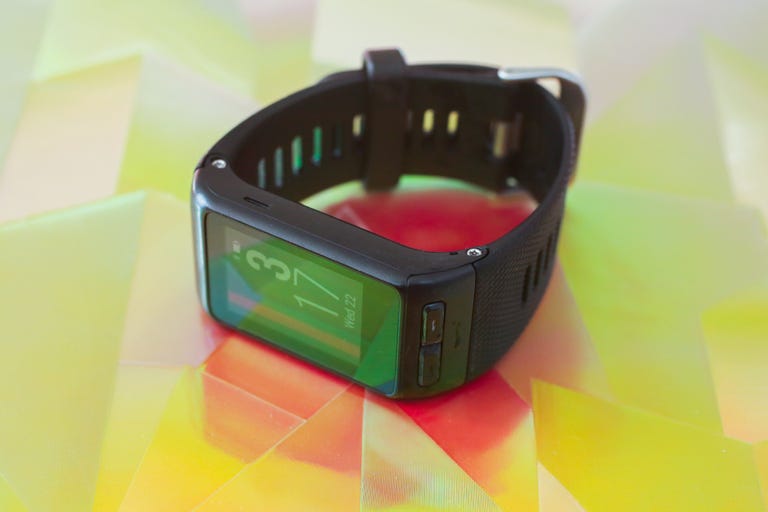 Why You Can Trust CNET
Why You Can Trust CNET Garmin Vivoactive HR review: A versatile multisport watch for active people
Garmin's latest watch offers fitness tracking, smartphone notifications, a built-in heart-rate sensor and long battery life. It also has GPS to track your activities.
I've had a busy month. I've been running, cycling, swimming, rowing and hiking. And I've done all of this while wearing a single watch, Garmin's Vivoactive HR. Unlike many of Garmin's other products, the watch won't appeal to just athletes. It's an everyday fitness band, but with smartwatch elements. It gives Fitbit a run for its everyday-fitness money and is a compelling solution for anyone with an active lifestyle.
The Good
The Bad
The Bottom Line
The Vivoactive HR seems to be able to do it all. There's all-day activity tracking (for things like steps, floors climbed, calories burned and sleep), smartphone notifications from your iPhone or Android device, a built-in optical heart-rate sensor and GPS for tracking a variety of activities. In addition to the ones I mentioned above, the watch can track golf, downhill and cross-country skiing, indoor cycling, indoor rowing, walking, strength training and even paddle boarding.
Even more impressive is that it can do all of this without having to be charged each night. The watch will last up to eight days, or around 13 hours with an active GPS signal. I typically got about a week, but that included five days of GPS workouts of between 40 and 50 minutes.
It's pretty clear that I'm a fan of the Vivoactive HR. It's a watch that active consumers will really enjoy and the $250 (£210, AU$400) pricetag is pretty reasonable (given all it does), but there a few things you need to know before you go out and buy one.
The design won't appeal to everyone
I really liked the slim design of the original Vivoactive, but the HR model is nothing like the original. It's similar to the Fitbit Surge, but that's not necessarily a good thing. The watch is big and bulky, and it's not something you would want to wear to the office, let alone a wedding.
It's not all bad, though. The Vivoactive HR is waterproof up to 50 meters. It also has an always-on display, which is easy to read outdoors, but can look a little dull when inside.
Wrist-based heart rate is getting better, but it's not perfect
The heart-rate sensor on the back of Vivoactive HR will be good enough for most people. It's relatively accurate on easy runs and when measuring resting heart rate (it does so continuously throughout the day). It's also a lot more convenient than wearing a chest strap.
But, like all wrist-based heart-rate solutions, it's not perfect. I did notice a slight delay of between five to seven seconds when compared to heart rate data recorded on a Polar H7 chest strap, but that's pretty standard for wrist-based sensors. I also found that it fluctuated when doing a hard interval workout, although it didn't perform as badly as some other devices (like the Gear Fit 2, for example).
If you want more accurate heart-rate data, there is the option of pairing a Garmin chest strap. You can also broadcast the heart-rate data to other devices, such as a Garmin Edge bike computer.
You can view the heart rate data in the charts below (give it a minute to load).
Garmin's mobile app needs work
The main problem I usually have with Garmin's products is software. Just like I experienced when reviewing the Forerunner 235, there were occasional hiccups with syncing and connection to my Android smartphone (I found the iPhone to be more stable). Connection problems weren't as frequent as with the original Vivoactive, but it is still an area where Garmin needs to improve.
All of the data from the watch is synced to the Garmin Connect mobile app on Android and iOS. The app serves up an impressive amount of information and can connect with numerous Garmin products, but it can be confusing to navigate. Even for someone like me who has used the app for the past few years, I sometimes find it difficult to locate specific metrics. Simply put, Garmin needs a better app.
Who should buy this?
The Vivoactive HR is designed for active consumers. It tracks all-day activities very well, and the waterproof design, long battery life and multiple sport profiles make it a better value than the Fitbit Surge.
While the watch is fully capable of tracking running, cycling and swimming, I wouldn't recommend it for dedicated runners and triathletes because it is missing some more advanced features they may find useful.
Garmin's Forerunner 230/235 adds interval training, custom workouts, a recovery advisor and VO2Max estimates (a metric used by athletes for measuring the maximum amount of oxygen that can be used during workouts). Meanwhile, triathletes would want to check out the Forerunner 735XT, older Forerunner 920XT or Fenix 3. All of these have an auto multisport feature that lets you switch sports with a single button press, which is a useful feature when competing in a triathlon or duathlon). You don't get these on this Vivoactive.
For the casual walker, runner, golfer, swimmer, biker or anyone else, though, the Vivoactive HR is a solid buy. More solid than Fitbit? In hardware, yes. In software, maybe not.


